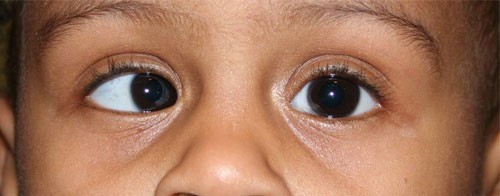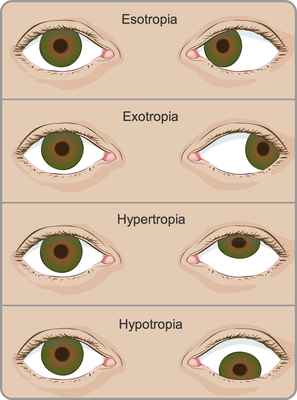
...
Squint or strabismus occurs when the eyes do not align or when one or both eyes wander.
It is a common problem that affects young children's vision, looks, and confidence if not diagnosed and treated early. It is a condition in which the eyes of an adult or kid point in separate directions. When staring at anything, a normal person's eyes are both straight ahead. Strabismus, often known as a squint, occurs when only one eye is gazing straight while the other is turned aside.The gaze may shift:
- inward (also known as "cross-eyed")
- externally (exotropia)
- down (hypotropia)
- up (hypertropia)
When the eyes do not line up, the straighter or more straight eye takes over. Because the eye and its link to the brain are functioning normally, the visual strength (acuity) of this eye remains normal. The misaligned or weaker eye, on the other hand, does not focus properly and its link to the brain does not develop properly.

A squinted eye may become unable to see well. This weak eye is known as a lazy eye. Lazy eye can only be cured if it is discovered and treated as soon as possible. The earlier therapy begins, the better the outcome.
A person who squints can only see with one eye at a time. A person with two good eyes can perceive distances and depth more correctly than someone with a squint. This may influence your child's future career and sports choices. A squint can also have an impact on your child's looks and self-esteem. As a result, it is sometimes preferable to operate on the child's squint from a young age. Last but not least, an eye with a squint may have additional problems that need to be treated.
For all of these reasons, every newborn or toddler who has a squint should see an eye expert.
What causes squints?
Strabismus can be congenital or develop throughout childhood. It is frequently caused by an issue with the muscles that move the eyes, and it can run in families.
The majority of children with strabismus are identified between the ages of one and four. After the age of six, a kid may acquire strabismus. If this occurs, the youngster should consult a doctor straight soon to rule out any other problems.
WHO AS A CHILD DEVELOPS STRABISMUS?
Strabismus is frequently seen in otherwise normal youngsters. However, those with brain problems such cerebral palsy, Down syndrome, hydrocephalus, and brain tumors are more prone to develop strabismus.
STRABISMUS IS CAUSED BY WHAT ADULT DISORDERS?
Adults with strabismus may have a stroke or vascular issues. Other common causes of strabismus include trauma, neurological issues, and Graves disease (thyroid eye illnesses).
STRABISMUS IS CAUSED BY TRAUMA IN WHAT WAY?
Strabismus can be caused by trauma in the following ways:
- Damage to the brain that inhibits regulation of eye movement,
- damage to the nerves that regulate eye movement, and/or
- injury to the eye muscles caused by trauma to the eye socket, either directly or indirectly.
Early detection of Squint signs
The majority of children with strabismus do not complain about eye issues or detect changes in their vision. A family member, teacher, or health care professional is usually the first to discover that the eyes are not straight.
Some children may complain of double vision (seeing two objects when only one is in view) or general vision problems. These issues can also have an impact on reading abilities and classroom learning. Younger children who aren't yet talking may squint a lot and turn or tilt their heads to see more clearly.
Inform your doctor if your kid exhibits any of these signs or symptoms. If necessary, he or she can send you to a pediatric ophthalmologist.
How Is Strabismus Detected?
During the first few months of life, it is typical for a newborn's eyes to wander or cross. However, at the age of 4-6 months, a baby's eyes normally straighten out. If one or both eyes continue to wander in, out, up, or down on a regular basis, it is most likely due to strabismus.
What are the Squint Treatment Options?
A kid with a squint requires an eye exam. This may take some time since young toddlers are sometimes difficult and may require sedation.
Patching, eyeglasses, eye medications, eye exercises, and surgery may all be used in treatment. Treatment using spectacles to correct any refractive defects may improve some forms of squint, but the spectacles must be worn most of the time to be successful. Because children frequently resist wearing their spectacles, it is the parents' obligation to ensure that they do so at all times.
Any lazy eye must be fixed. The most successful way is to cover the youngster's healthy eye with a patch, forcing the child to use the lazy eye. Adequate treatment of lazy eye enhances surgical outcomes.
Finally, the eyes must be corrected to enhance the look and allow the infant to utilize both eyes simultaneously, which is commonly accomplished by surgery. Surgery is only indicated if patching and eyeglasses are ineffective.
What Is the Treatment for Strabismus?
The earlier strabismus is treated, the better the outcome. This is because essential connections between a child's eyes and brain establish by the age of eight.
Strabismus treatment may include:
- eyeglasses
- eye patching
- eye drops eye
- muscle surgery
Wearing glasses might sometimes be enough to straighten up the eyes. If this is not possible, a youngster may be given an eye patch to wear over the straight eye for a few hours each day. This patch forces the weaker eye to perform the "seeing" function. The muscles and vision in the weaker eye improve with time.
It might be difficult to convince an infant or toddler to wear an eye patch. However, most children become used to the patch. Wearing it becomes as natural to them as getting dressed in the morning.
However, some children refuse to wear an eye patch. Then eye drops (known as atropine drops) may be used instead. Similar to how eye patching restricts vision in the straight eye, atropine drops temporarily obscure vision in that eye. This causes the weaker eye to work harder, strengthening the eye muscles and eyesight.
If eyeglasses, eye patching, and/or atropine drops are ineffective in treating a child's strabismus, eye muscle surgery may be required. The muscles that cause the eye to wander are either loosened or tightened during surgery. Most children can go home on the same day as their procedure.
What Else Do I Need to Know?
The best approach to identifying strabismus is to have regular eye exams. Early detection and treatment increase a child's chances of acquiring strong eyesight and depth perception. However, older children and teenagers (as well as many adults with strabismus) can still benefit from therapy.
Keep the social element of strabismus in mind as well. Adults and children both benefit from aligned eyes for a positive self-image.
American Association for Pediatric Ophthalmology & Strabismus, kidshealth, Amanda J. Bourgeois,

Add new comment